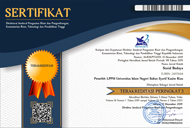Beyond Dangdut: Nurturing Local Language Using Lyrics
Abstract
Keywords
Full Text:
PDFReferences
Arifin, Ferdi. 2017. “Citra Perempuan Dalam Lirik Lagu Kimcil Kepolen Karya Ndx Aka Familia Dalam Perspektif Linguistik Kognitif.” Jurnal Bahasa Lingua Scientia 9 (2): 161–76. https://doi.org/10.21274/ls.2017.9.2.161-176.
Bader, Sandra. 2011. “Dancing Bodies on Stage.” Indonesia and the Malay World 39 (115): 333–55. https://doi.org/10.1080/13639811.2011.614085.
Bianco, Joseph Lo. 2004. “Language Planning as Applied Linguistics.” In The Handbook of Applied Linguistics, edited by Alan Davies and Catherine Elder, 738–62. Oxford: Blackwell Publishing.
Browne, Susan. 2000. “The Gender Implications of Dangdut Kampungan: Indonesian Low-Class Popular Music.” 109. 0314-6804. Melbourne.
Campbell, Lyle, Raina Heaton, Nala Lee, Eve Okura, Sean Simpson, Kaori Ueki, and John Van Way. 2013. “New Knowledge: Findings from the Catalogue of Endangered Languages (‘ELCat ’).” In International Conference on Language Documentation and Conservation. Honohulu: University of Hawai‘i.
Croker, Robert A. 2009. “An Introduction to Qualitative Research.” In Qualitative Research in Applied Linguistics: A Practical Introduction, edited by Juanita Heigham and Robert A. Croker, 3–41. New York: Palgrave Macmillan.
Crystal, David. 2000. Language Death. Cambridge: Cambridge University Press.
Daniels, Timothy P. 2013. “Social Drama, Dangdut, and Popular Culture.” In Performance, Popular Culture, and Piety in Muslim Southeast Asia, edited by Timothy P. Daniels, 161. New York: Palgrave Macmillan.
David, Bettina. 2014. “Seductive Pleasures, Eluding Subjectivities: Some Thoughts on Dangdut’s Ambiguous Identity.” In Sonic Modernities in the Malay World: A History of Popular Music, Social Distinction and Novel Lifestyles (1930s–2000s), edited by Bart Barendregt, 249–70. Leiden: BRILL.
Fahrudin, Tresna Maulana, and Ali Ridho Barakbah. 2018. “Lyric Text Mining Of Dangdut: Visualizing The Selected Words And Word Pairs Of The Legendary Rhoma Irama’s Dangdut Song In The 1970s Era.” SYSTEMIC: Information System and Informatics Journal 4 (2): 9–17. https://doi.org/https://doi.org/10.29080/systemic.v4i2.432.
Frederick, William H. 1982. “Rhoma Irama and the Dangdut Style: Aspects of Contemporary Indonesian Popular Culture.” Indonesia 34: 102–30. https://doi.org/10.2307/3350952.
Harimansyah, Ganjar. 2017. Pedoman Konservasi Dan Revitalisasi Bahasa. Edited by Mustakim and Wawan Prihantoro. Jakarta: Badan Pengembangan dan Pembinaan Bahasa.
Idntimes.com. 2019. “Ditonton Jutaan Orang Dalam Sehari, 5 Fakta Single Terbaru Via Vallen.” Www.Idntimes.Com. 2019. https://www.idntimes.com/hype/entertainment/andi-aris/ditonton-jutaan-orang-dalam-sehari-5-fakta-single-terbaru-via-vallen/full.
King, Kendall A. 2001. Language Revitalization Processes and Prospects: Quichua in the Ecuadorian Andes. Paris: Multilingual Matters LTD.
Kompas.com. 2017. “Perlu Sinergi Pelestarian Bahasa Daerah Artikel Ini Telah Tayang Di Kompas.Com Dengan Judul ‘Perlu Sinergi Pelestarian Bahasa Daerah’,.” Www.National.Kompas.Com. 2017. https://nasional.kompas.com/read/2017/02/23/20473671/perlu.sinergi.pelestarian.bahasa.daerah.
Kontan.co.id. 2019. “Atta, Ricis, Bapau,Dan Raffi.” Www.Analis.Kontan.Co.Id. 2019. https://analisis.kontan.co.id/news/atta-ricis-bapaudan-raffi.
Koran Sindo. 2017. “Ini Dia, 10 Bahasa Daerah Dengan Penutur Terbanyak Di Indonesia.” Www.National.Sindonews.Com. 2017. https://nasional.sindonews.com/read/1252853/15/ini-dia-10-bahasa-daerah-dengan-penutur-terbanyak-di-indonesia-1509344321.
Krauss, Michael. 2007. “Classification and Terminology for Degrees of Language.” In Trends in Linguistics Studies and Monographs, edited by Walter Bisang, Hans Henrich Hock, and Werner Winter, 1–8. Berlin . New York: Mouton de Gruyter.
Lynch, Tony, and David Mendelsohn. 2010. “Listening.” In An Introduction to Applied Linguistics, edited by Norbert Schmitt, 180–96. London: Hodder & Stoughton Ltd.
McGroarty, Mary. 1997. “Language Policy in the USA: National Values, Local Loyalties, Pragmatic Pressures.” In Language Policy: Dominant English, Pluralist Challenges, edited by W. Eggington and H. Wren. Amsterdam: John Benjamins.
Nurdiarsih, Fadjriah. 2018. “UNESCO Ungkap Bahasa Daerah Di Indonesia Punah Setiap 15 Hari Sekali.” Www.Liputan6.Com. 2018. https://www.liputan6.com/news/read/3469714/unesco-ungkap-bahasa-daerah-di-indonesia-punah-setiap-15-hari-sekali.
Permana, Catur Surya. 2019. “Dangdut: Java, Reggae and Rap A Collaborative Concept of Via Vallen.” In Proceedings of the International Conference on Arts and Design Education (ICADE 2018). Paris, Amsterdam, Hongkong, Beijing: Atalntis Press. https://doi.org/https://doi.org/10.2991/icade-18.2019.46.
Pioquinto, Ceres E. 1995. “Dangdut at Sekaten: Female Representations in Live Performance.” RIMA: Review of Indonesian and Malaysian Affairs 29 (1): 59–89.
Rachmawati, Ira. 2018. “11 Bahasa Daerah Di Indonesia Dinyatakan Punah, Apa Saja?” Www.Kompas.Com. 2018. https://regional.kompas.com/read/2018/02/10/18293411/11-bahasa-daerah-di-indonesia-d.
Rahayu, Bety Agustina. 2018. “Dangdut Music Affects Behavior Change at School and Adolescent Youth in Indonesia: A Literature Review.” Health Science Journal 12 (1): 1–4. https://doi.org/10.21767/1791-809X.1000552.
Rayendra, Panditio. 2014. “Wow! ‘Dangdut Academy’ Indosiar Puncaki Rating.” Www.Tabloidbintang.Com. 2014. https://www.tabloidbintang.com/film-tv-musik/kabar/read/3641/Wow-Dangdut-Academy-Indosiar-Puncaki-Rating.
Sen, Krishna, and David T Hill. 2000. Media, Culture and Politics in Indonesia. Melbourne: Oxford University Press.
Socialblade.com. 2018a. “Ricis Official.” Www.Socialblade.Com. 2018. https://www.youtube.com/channel/UC4tS4Q_Cno5JVcIUXxQOOpA/search?query=bojo+galak.
———. 2018b. “Ricis Official.” Www.Socialblade.Com. 2018. https://www.youtube.com/channel/UC4tS4Q_Cno5JVcIUXxQOOpA/search?query=konco+mesra.
———. 2018c. “Via Vallen - Sayang - Indonesian Choice Awards 5.0 NET.” Www.Socialblade.Com. 2018. https://socialblade.com/youtube/user/netmediatama/videos/mostviewed.
———. 2019a. “Ria Ricis Official.” Www.Socialblade.Com. 2019. https://socialblade.com/youtube/channel/UC4tS4Q_Cno5JVcIUXxQOOpA.
———. 2019b. “Via Vallen Official.” Www.Socialblade.Com. 2019. https://socialblade.com/youtube/channel/UCaHVygCd_tAPmvxVZ85DbDw/monthly.
UNESCO. 2003. “Language Vitality and Endangerment.” Paris. http://www.unesco.org/new/fileadmin/MULTIMEDIA/HQ/CLT/pdf/Language_vitality_and_endangerment_EN.pdf.
Wallach, Jeremy Wayne. 2002. “Modern Noise and Ethnic Accents: Indonesian Popular Music in the Era of Reformasi.” University of Pennsylvania.
Weintraub, Andrew N. 2006. “Dangdut Soul: Who Are ‘the People’ in Indonesian Popular Music?” Asian Journal of Communication 16 (4): 411–31. https://doi.org/10.1080/01292980601012444.
Weintraub, Andrew N. 2010. Dangdut Stories: A Social and Musical History of Indonesia’s Most Popular Music. Oxford: Oxford University Press.
Wichelen, Sonja van. 2005. “‘My Dance Immoral? Alhamdulillah No!’ Dangdut Music and Gender Politics in Contemporary Indonesia.” In Resounding International Relations on Music, Culture, and Politics, edited by M.I. Franklin, 161–77. New York: Palgrave Macmillan US.
Wierzbicka, Anna. 1992. Semantics, Cognition, and Culture. London: Oxford University Press.
Williams, Sean. 1990. “Current Developments in Sundanese Popular Music.” Asian Music 21 (1): 105–36. https://doi.org/10.2307/834075.
Wodak, Ruth. 2006. “Linguistic Analyses in Language Policies.” In An Introduction to Language and Policy: Theory and Method, edited by Thomas Ricento, 170–93. Oxford: Blackwell.
Yampolsky, Philip. 1995. “Indonesian Popular Music: Kroncong, Dangdut, and Langgam Jawa.” Performing Arts in Southeast Asia, 700–725. http://www.jstor.org/stable/27864710.
DOI: http://dx.doi.org/10.24014/sb.v16i1.7035
Refbacks
- There are currently no refbacks.
Published by:
Center for Research and Community Development
Universitas Islam Negeri Sultan Syarif Kasim Riau
Jl. H. R. Soebrantas KM 15,5 ,Tuah Madani, Tampan,
Pekanbaru, Riau 28293
Indexed By:


.jpg)



